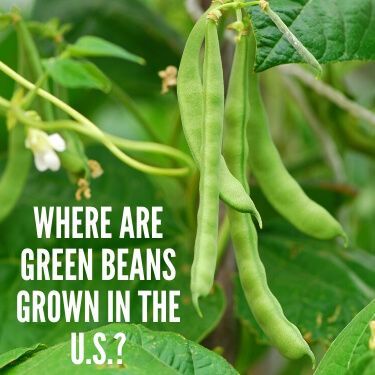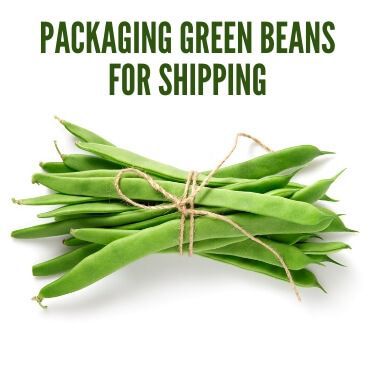The harvest is in. You’re ready to have those delightful green beans transported after they are picked and packed. But you don’t have a truck or maybe a clue on how to get those popular vegetables from the farm or processing plant to a customer’s table.
Getting a truck to where you are isn’t all that hard though. Once you have a better grasp on how to handle and get those green beans transported, you’ll be on your way to turning this nutritious food into another kind of green. Read below to learn more about green beans and on how to protect your veggie investment.

Green beans are also known as snap beans or string beans and are able to be grown around the world. There are very few places in the United States green beans are unable to grow but several states do make up the bulk of America’s production.
Wisconsin is by far the nation’s leader, with the midwestern state producing more green beans than the next two states — Florida and New York — combined. In 2018 alone, 37 percent of all green beans grown in America came from Wisconsin, with a little less than 30 percent combined from Florida and New York.
Green beans don’t do well in the cold, which might make Wisconsin and New York seem like strange places for them to thrive. However, the vegetable is planted in about mid-May in those states and harvested 10 to 12 weeks later.
Do you need to know how to transport lima beans? See how an expert freight partner can help.
The conditions while harvesting green beans have to be just so. Before worrying about handling them postharvest, it’s first good to know that the vegetable will most thrive if picked while the plant is dry with no moisture content present. This will help stop the spread of diseases and also halt contamination from the soil.
Once this occurs, postharvest tips to keep those green beans in tip top shape include keeping the beans away from direct sunlight. You also don’t want to wait very long to get them in shade and cooled off — the recommendation is not more than 1 to 2 hours without cooling before deterioration sets in and shelf life is diminished. Fabric bags are good for this.
Depending on how the green beans are harvested will dictate how they are packaged for shipping. If the vegetable in question is handpicked, they are usually packed right there in the field. However, for bigger operations that use mechanical harvesters, the beans will be picked and then loaded for transport to a processing plant or packing shed.
Even having said that, green beans must be handled carefully because they are fragile and can be bruised or broken during the loading and unloading process. Also, how you handle green beans will be further impacted by if you are shelling them while they’re out in the field or not.
If practicing in-field shelling, care has to be taken to make sure the center of the load doesn’t overheat and ruin those green beans. The temperature there can go over 140 degree fahrenheit in the center of a large load, which can cause the produce to wilt and spoil before it gets to the pack. Hydrocooling — basically running chilled water over the green beans — is a popular method for making sure they don’t overheat.
Besides the heat, green beans are truly a warm weather plant. However, they should be stored at temperatures between 37 and 45 degrees with 95 percent relative humidity. So a refrigerated truck is probably needed to ship them, and in these conditions, the snap beans will retain a high level of quality for 7 to 10 days.
Like green beans, other veggies have special shipping considerations. Wondering how are bell peppers transported? Learn more from an expert freight partner that ranks among top produce shipping companies.

Green beans are usually shipped in one of three ways:
The green beans themselves can go in a plastic bag — preferably of the polyethylene variety. This can reduce the chance that the green beans begin turning brown.
Even though a cool environment with high humidity was recommended two sections ago, do not ship the green beans wet. This will lead to quality loss.
Also ethylene gas, which is commonly given off by some fruits, will hasten the decline of the green beans. They shouldn’t be shipped with bananas, tomatoes, cantaloupes and apples for this reason. Also green beans can absorb the odors of cantaloupes, peppers and onions, so they shouldn’t be shipped with or stored with this produce either.
Earlier it said that 37 to 45 degrees is the optimal temperature for green beans. While that is absolutely true, an unwelcome chilling effect can set in starting at 38 degrees, which is something to watch for.
Once you’ve harvested your crops and are ready, call R+L Global Logistics to have your green beans transported to all points across America. We can get those snap beans quickly from the processing plant to the farmers market, grocery stores or restaurants so people can taste the freshness and quality of your hard work.
With strategic alliances throughout the U.S. and over 30 years of experience, R+L Global Logistics is a trusted partner — especially if you want your vegetables delivered according to schedule. With a 99.5 percent on-time rate, there is little doubt the green beans will arrive ready to eat.
For those times you might need to get those green beans to their end destination just a bit quicker than usual, R+L Global Logistics offers expedited shipping. Regardless of standard or expedited shipping, anyone using us to transport their freight gets real-time visibility for their load and 24/7 customer service to deal with any questions or concerns that arise.
So when you’re ready to have your green beans transported, contact us here at R+L Global Logistics to hear about our freight services. We handle everything from green beans transport to help with tobacco transportation laws and more. Call us today at (866) 353-7178 for a free freight quote today to see how we can help you accomplish your business goals.
Green beans are usually shipped in one of three ways:
Wirebound crates
Hampers
Fiberboard cartons
Wisconsin is by far the nation’s leader, with the midwestern state producing more green beans than the next two states — Florida and New York — combined. In 2018 alone, 37 percent of all green beans grown in America came from Wisconsin, with a little less than 30 percent combined from Florida and New York.
Even though a cool environment with high humidity was recommended two sections ago, do not ship the green beans wet. This will lead to quality loss.
Also ethylene gas, which is commonly given off by some fruits, will hasten the decline of the green beans. They shouldn’t be shipped with bananas, tomatoes, cantaloupes and apples for this reason. Also green beans can absorb the odors of cantaloupes, peppers and onions, so they shouldn’t be shipped with or stored with this produce either.
R+L Global Logistics
315 NE 14th St., Ocala, FL 34470